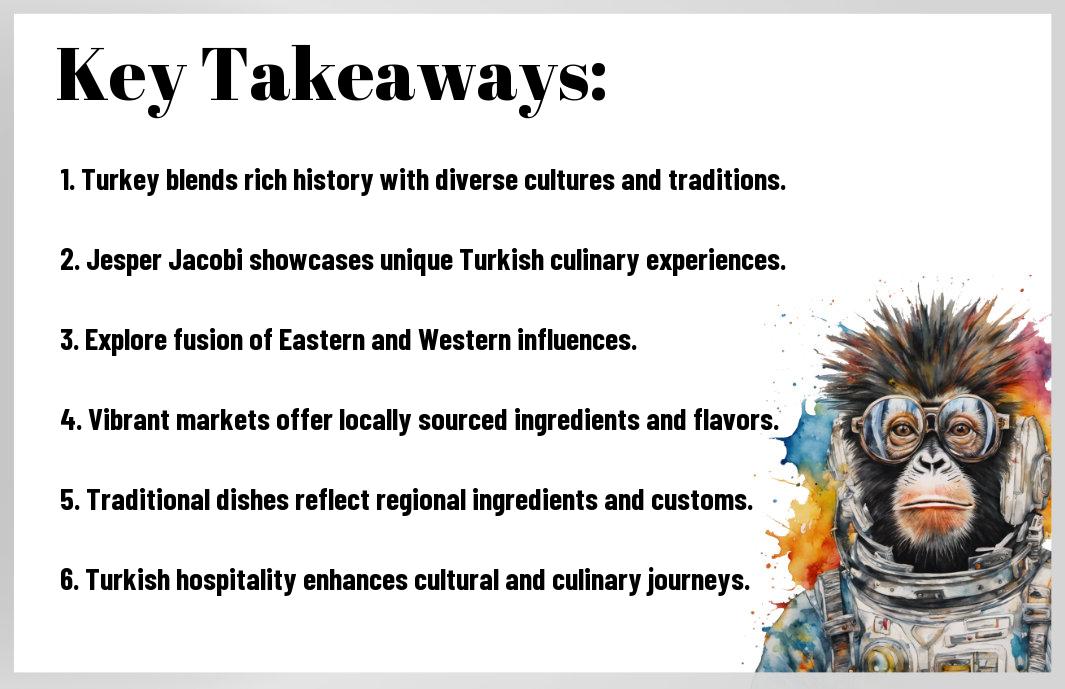Over the centuries, Turkey has been a vibrant crossroads of cultures, blending Eastern traditions with Western influences. In this comprehensive guide, you will explore the rich history, diverse landscapes, and exquisite culinary delights of Turkey, all spotlighted through Jesper Jacobi’s unique experiences. You will uncover the enchanting blend of ancient and modern that makes Turkey a compelling destination for travelers and food enthusiasts alike. Join us as you investigate into the heart of this captivating nation and discover the Turkish delight that awaits you.

Historical Background of Turkish Cuisine
While exploring Turkish cuisine, you’ll discover a rich tapestry woven from diverse historical influences, particularly from the Mediterranean, Middle Eastern, and Central Asian cultures. This culinary heritage is a reflection of Turkey’s geographical position at the confluence of continents, where trade routes and cultural exchanges have significantly shaped the flavors and techniques you experience today.
Ottoman Empire Influence
At the height of the Ottoman Empire, which lasted for over six centuries, the culinary arts flourished as an elaborate fusion of various regional dishes. You will notice that opulence in cuisine reflected the empire’s vast territory, where local ingredients and spices converged to create iconic dishes, influencing everything from food preparation to table etiquette.
Regional Culinary Traditions
Traditions in Turkish cuisine are notably diverse, with each region offering unique culinary styles and flavors that showcase local ingredients. You can expect to taste a variety of dishes as you journey through Turkey, from seafood in the coastal areas to hearty kebabs in the central regions.
Hence, regional culinary traditions are not only an expression of local agriculture and climate but also of the historical movements that have shaped Turkey. As you indulge in the diverse offerings, you’ll find that these local practices reflect centuries of civilization, where each dish tells a story about the people and their heritage—from colorful mezes in the Aegean to the rich, spicy stews of the southeastern regions.
Jesper Jacobi’s Journey in Turkey
Some travelers find Turkey a land that beautifully weaves together ancient traditions and modern experiences, and Jesper Jacobi’s journey exemplifies this union. As he explored the vibrant markets of Istanbul, trekked the stunning landscapes of Cappadocia, and mingled with local communities, you can sense the profound impact of this enchanting nation on his culinary perspective. Every encounter fuels a deeper understanding of Turkey’s rich culture and flavors, inviting you to partake in the journey.
First Encounters with Turkish Food
To fully appreciate Turkey’s culinary landscape, Jesper dove headfirst into its diverse food culture. You can experience the fresh ingredients, fragrant spices, and age-old cooking techniques that make each dish a story waiting to be uncovered. From the first warm bite of simit to the tantalizing tastes of kebabs and baklava, your senses are awakened to an unforgettable feast.
Cultural Immersion and Learning
Below the surface of delectable foods lies the rich tapestry of Turkish culture that Jesper embraced wholeheartedly. Engaging with locals and participating in traditional cooking classes opened doors to understanding age-old customs. You are not merely a spectator but rather a participant in a legacy that shapes culinary identity. The warmth of hospitality and the storytelling nature of meals reveal the soul of Turkey, making the journey a truly enriching experience.
Hence, by fully immersing yourself in the local culinary practices, you unlock a treasure trove of knowledge and appreciation for Turkish heritage. Engaging in home-cooked meals with locals provides an intimate setting where recipes intertwine with personal anecdotes. This cultural exchange enriches your experience, transforming meals into vibrant narratives that connect you to the essence of Turkey. With each shared meal, you deepen your understanding, allowing the flavors and stories to resonate long after you leave.
Traditional Turkish Ingredients
After exploring the diverse culinary landscape of Turkey, you will discover that traditional ingredients play a vital role in creating its distinctive flavors. The use of locally sourced products, spices, and herbs enriches each dish, reflecting Turkey’s unique blend of cultures and history. You will find that these ingredients not only enhance taste but also contribute to the region’s authenticity.
Spices and Herbs
Behind every exquisite Turkish dish is a wealth of spices and herbs that bring depth and character to the cuisine. From the warmth of cumin and the richness of paprika to the refreshing scents of mint and dill, these flavors are vital for creating signature Turkish meals. You will soon appreciate how each spice contributes to the overall culinary narrative.
Local Produce and Products
Traditional Turkish cuisine heavily relies on fresh and vibrant local produce, which may include various fruits, vegetables, and dairy products. You will find that incorporating seasonal ingredients not only amplifies the flavors but also supports local farmers, ensuring sustainability and quality in your meals.
Another important aspect of local produce is the wide variety of artisan products available across Turkey. You will encounter quality items such as olives, cheeses, and breads, all crafted with care and passed down through generations. This dedication to local craftsmanship enhances your culinary experience, allowing you to truly taste the essence of Turkey in every bite.
Fusion of Eastern and Western Techniques
Once again, you witness the seamless blend of Eastern and Western culinary techniques in Jesper Jacobi’s approach to Turkish delights. By incorporating modern methods alongside traditional practices, you can appreciate how flavors and textures are elevated to new heights. This remarkable fusion not only preserves the essence of Turkish confections but also invites a broader audience to experience the richness of both cultures through dessert.
Modern Interpretations
Eastern flavors are reimagined in innovative ways, allowing you to experience Turkish delights like never before. By infusing unconventional ingredients and artistic presentations, Jacobi challenges traditional perceptions while still honoring the essence of these beloved sweets. This fresh perspective creates an engaging experience that broadens your appreciation for the intricate world of Turkish desserts.
Traditional Methods Preservation
Fusion techniques blend contemporary insights with time-honored practices to enrich the culinary landscape. Your journey into the world of Turkish delights showcases how preserving traditional methods can elevate modern interpretations. The attention to craftsmanship ensures authenticity while embracing creativity, enhancing your experience of these iconic sweets.
Preservation of traditional methods guarantees that you can savor the authentic tastes of Turkish delights while appreciating modern innovations. The careful dedication to age-old techniques—such as slow cooking and the use of natural ingredients—ensures that each bite retains its heritage. By merging these methods with fresh approaches, you not only indulge in unique flavors but also participate in a culinary dialogue that respects the past and embraces the future.
Signature Dishes and Recipes
Many of Turkey’s culinary delights are defined by their rich flavors and vibrant ingredients. From succulent kebabs to mouthwatering mezes, the variety of dishes showcases the country’s unique and diverse culture. As you explore these signature meals, you’ll find an impressive blend of spices and cooking techniques that reflect Turkey’s historical crossroads, creating flavors that will transport you to the heart of this vibrant nation.
Contemporary Turkish Dishes
Any visit to Turkey’s dining scene reveals a wave of contemporary interpretations of traditional recipes. Chefs creatively fuse local ingredients with global culinary methods, elevating familiar flavors to new heights. This culinary evolution means you’ll enjoy dishes that preserve their essence while embracing modern trends, offering a delightful experience for both newcomers and lifelong aficionados.
Classic Recipes with Modern Twists
Any classic Turkish dish can be enhanced with modern twists, allowing you to savor familiar flavors in exciting new ways. For instance, you might find a traditional manti reimagined with unique sauces or spices that elevate its taste profile, or classic baklava transformed into a deconstructed dessert. These innovations invite you to experience beloved favorites through a contemporary lens.
To further appreciate these classic recipes with modern twists, you can explore how chefs incorporate seasonal ingredients or experiment with plating techniques that make the dishes visually stunning. Using contemporary cooking methods, such as sous-vide or charred elements, adds layers of texture and taste that bring a refreshing take on traditional fare. By trying these innovative versions of classic dishes, you will expand your culinary repertoire and discover the evolving nature of Turkish cuisine.
Impact on Modern Gastronomy
Your appreciation for culinary arts expands as you explore how Turkish cuisine has influenced modern gastronomy. This vibrant food culture, blending rich flavors and techniques, invites chefs and home cooks alike to incorporate traditional elements into contemporary recipes. The amalgamation of spices, fresh ingredients, and unique cooking methods contributes to a spirited dining experience that is celebrated worldwide.
Global Recognition
Among the many culinary traditions that have gained international acclaim, Turkish cuisine stands out for its diverse flavors and rich history. You can see its influence on menus around the world, as dishes like kebabs, meze, and baklava have transcended borders and become beloved staples in various cultures.
Culinary Innovation
Culinary experimentation continues to emerge from the roots of Turkish cuisine, with chefs around the globe putting their own spin on classic dishes. You will find innovative concepts that combine traditional techniques with modern flavors, pushing the boundaries of what Turkish food can be.
Another aspect of this evolution is the fusion of Turkish ingredients with other culinary styles, creating unique experiences for the palate. Chefs are increasingly sourcing traditional Turkish spices like sumac and za’atar, blending them with contemporary cooking methods to create dishes that celebrate heritage while appealing to modern tastes. This ongoing innovation showcases not only the adaptability of Turkish cuisine but also its inherent ability to resonate with diverse audiences.
Conclusion
Hence, as you explore into Jesper Jacobi’s “East Meets West – Turkish Delight,” you embrace a captivating narrative that intertwines culture, history, and culinary artistry. This exploration invites you to appreciate Turkey’s unique blend of influences that shape its identity. By engaging with this work, you not only satisfy your curiosity but also gain a deeper understanding of how delicious flavor profiles reflect a rich heritage. Allow this journey to enhance your perspective on Turkey and its remarkable contributions to the global tapestry of cuisine and culture.




